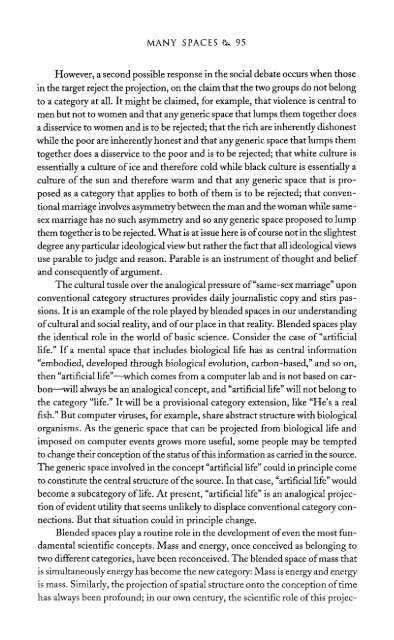The Literary Mind.pdf
The Literary Mind.pdf
The Literary Mind.pdf
Create successful ePaper yourself
Turn your PDF publications into a flip-book with our unique Google optimized e-Paper software.
MANY SPACES 95<br />
However, a second possible response in the social debate occurs when those<br />
in the target reject the projection, on the claim that the two groups do not belong<br />
to a category at all. It might be claimed, for example, that violence is central to<br />
men but not to women and that any generic space that lumps them together does<br />
a disservice to women and is to be rejected; that the rich are inherently dishonest<br />
while the poor are inherently honest and that any generic space that lumps them<br />
together does a disservice to the poor and is to be rejected; that white culture is<br />
essentially a culture of ice and therefore cold while black culture is essentially a<br />
culture of the sun and therefore warm and that any generic space that is proposed<br />
as a category that applies to both of them is to be rejected; that conventional<br />
marriage involves asymmetry between the man and the woman while samesex<br />
marriage has no such asymmetry and so any generic space proposed to lump<br />
them together is to be rejected. What is at issue here is of course not in the slightest<br />
degree any particular ideological view but rather the fact that all ideological views<br />
use parable to judge and reason. Parable is an instrument of thought and belief<br />
and consequently of argument.<br />
<strong>The</strong> cultural tussle over the analogical pressure of "same-sex marriage" upon<br />
conventional category structures provides daily journalistic copy and stirs passions.<br />
It is an example of the role played by blended spaces in our understanding<br />
of cultural and social reality, and of our place in that reality. Blended spaces play<br />
the identical role in the world of basic science. Consider the case of "artificial<br />
life." If a mental space that includes biological life has as central information<br />
"embodied, developed through biological evolution, carbon-based," and so on,<br />
then "artificial life"—which comes from a computer lab and is not based on carbon—will<br />
always be an analogical concept, and "artificial life" will not belong to<br />
the category "life." It will be a provisional category extension, like "He's a real<br />
fish." But computer viruses, for example, share abstract structure with biological<br />
organisms. As the generic space that can be projected from biological life and<br />
imposed on computer events grows more useful, some people may be tempted<br />
to change their conception of the status of this information as carried in the source.<br />
<strong>The</strong> generic space involved in the concept "artificial life" could in principle come<br />
to constitute the central structure of the source. In that case, "artificial life" would<br />
become a subcategory of life. At present, "artificial life" is an analogical projection<br />
of evident utility that seems unlikely to displace conventional category connections.<br />
But that situation could in principle change.<br />
Blended spaces play a routine role in the development of even the most fundamental<br />
scientific concepts. Mass and energy, once conceived as belonging to<br />
two different categories, have been reconceived. <strong>The</strong> blended space of mass that<br />
is simultaneously energy has become the new category: Mass is energy and energy<br />
is mass. Similarly, the projection of spatial structure onto the conception of time<br />
has always been profound; in our own century, the scientific role of this projec-















